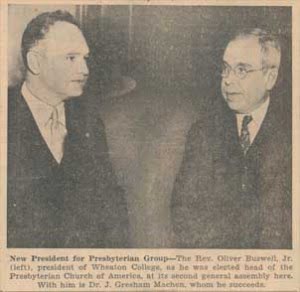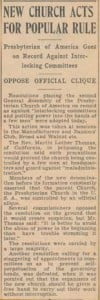As a bonus, and as our church this morning observed the Lord’s Supper, here is an interesting quote, accompanied by two recipes.
Communion Bread
“In some parts of Scotland, short bread was till quite recently chosen as the most appropriate bread for the Christian passover. [i.e., communion]. During the first year of my own ministry in Galloway, I was one day accosted by the beadle [i.e., sexton], and told that he and his friends were hoping I would give them short bread at the sacrament. ‘We used to have it till three years ago’, he said, ‘and we thought it very shabby in the minister to change the old custom and give us plain bread.’ . . . I cannot make out whether shortbread was ever used or not at the communion in Maunchline. I have heard old people say that in their fathers’ or grandfathers’ days it was used in some Parishes in Ayrshire, and the expression in our records two hundred years ago, ‘bringing home the bread,’ rather indicates that it was not ordinary bread that was used, but bread that had to be brought from a distance. At the present day, as may be seen from the last published volume of the Queen’s Journal, the communion bread in some parts of Aberdeenshire is cut into small cubes like dice. These are put on large plates, and on the top of them are two or three longer peces of bread for the ministers to break before distribution . . . ”
Source: Old Church Life in Scotland: Lectures on Kirk-Session and Presbytery Records, by Andrew Edgar (London: Alexander Gardner, 1885), pp. 148-149. As cited in Communion Tokens: Their Origin, History and Use, by Mary McWhorter Tenney (Grand Rapids: Zondervan, 1936), p. 52, where she adds in footnote 121 that “Shortbread is a peculiarly Scottish cake. There is not taint of leaven in its composition. This is the reason they assigned for using it.” Elsewhere, I have seen another statement, which I like, that shortbread was used, “because we bring the Lord the best we have.”
Two Recipes for Communion Bread, courtesy of Roberta Collison:
Grandcote Reformed Presbyterian Church (PCA), Coulterville, Illinois recipe:
2-3 cups of flour
1 tsp of baking powder
A pinch of salt
1/2 cup of sugar
1/4 cup of shortening
1 egg
1/2 cup of milk
Cut the shortening into the first four ingredients. Blend in beaten egg and milk. Roll out on cookie sheet and score into 1/2 inch squares, before baking at 350 degrees for 10 minutes.
The Covenant Presbyterian Church, St. Louis, Missouri recipe:
3 cups of flour
1/2 cup of sugar
1/2 cup of Crisco shortening
2 tsp of baking powder
1/2 tsp of salt
3/4 cup of milk
Cut in shortening to dry ingredients. Add milk. Blend. roll on floured surface. Finish pressing into approximately 12″ x 18″ jelly roll pan. Cut before baking at 350 degrees for 20 minutes. Cut again before cooling. Serves 550-600.





